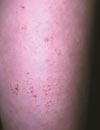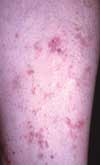- Clinical Technology
- Adult Immunization
- Hepatology
- Pediatric Immunization
- Screening
- Psychiatry
- Allergy
- Women's Health
- Cardiology
- Pediatrics
- Dermatology
- Endocrinology
- Pain Management
- Gastroenterology
- Infectious Disease
- Obesity Medicine
- Rheumatology
- Nephrology
- Neurology
- Pulmonology
Which Rashes Are the Result of a Drug Reaction?
Test your knowledge of dermatology with 4 cases, 4 photos, 4 different rashes . . . which are the result of a drug reaction?

Case 1:
A 63-year-old woman who recently started taking a new NSAID for long-standing osteoarthritis presents with a progressive, slightly tender rash that erupted, primarily on the lower extremities, several days ago. She has no fever or chills. She has taken the same antihypertensive and statin for several years.
What does this look like to you?
A. Drug-induced vasculitis from the NSAID.
B. Drug-induced vasculitis from the statin.
C. Drug-induced vasculitis from the antihypertensive.
D. Collage vascular disease-induced vasculitis.
E. Hepatitis C-induced vasculitis.
Which of the following would be included in the workup?
F. Detailed history taking for recent infections.
G. Complete blood cell count.
H. Urinalysis.
I. Liver function tests.
J. Antinuclear antibody assay.
K. Skin biopsy.
(Answer on next page.)


Case 1:
A biopsy confirmed a leukocytoclastic vasculitis with eosinophilia. Because the onset of the eruption corresponded with the initiation of therapy with the new NSAID, a diagnosis of
drug-induced vasculitis from the NSAID, A,
was made. All the other entities in the differential are possible diagnoses, but choice A is the most likely, given the time frame. The patient's rash resolved with a 10-day tapering course of prednisone.
All the workup choices are reasonable options to rule out other causes and to evaluate the extent of organ involvement.

Case 2:
A 36-year-old woman has been bothered by a pruritic rash of several weeks' duration on sun-exposed areas (face, neck, hands, and arms). She does not use any prescription medication. She takes vitamin supplements and recently switched to a new brand.
What type of outbreak is this?
A. Photoaggravated rosacea.
B. Photoallergic reaction to sunscreen in her moisturizer.
C. Photodrug reaction.
D. Cutaneous lupus erythematosus.
E. Contact dermatitis.
(Answer on next page.)

Case 2:
A biopsy confirmed a
photodrug reaction, C.
The rash re-solved with discontinuation of the vitamins. The patient did not bring a sample of the product with her, so it was impossible to identify the potential sensitizer.
Rosacea does not commonly appear on the hands and is not generally pruritic. A reaction to the sunscreen is possible, but the rash also occurred on the neck and arms-areas where she did not apply moisturizer. The biopsy ruled out cutaneous lupus erythematosus. Contact dermatitis is unlikely because of the lack of an exposure history.

Case 3:
For several weeks, an 11-year-old girl has had itchy shins. She plays soccer and wears shin guards. Although she bathes frequently, she has not used any new soaps. The family has a dog, and there is a family history of asthma.
What is the cause of the itchy shins?
A. Scabies.
B. Contact dermatitis.
C. Atopic dermatitis.
D. Psoriasis.
E. Lichen simplex chronicus.
(Answer on next page.)

Case 3:
This patient had a flare of
atopic dermatitis, C,
attributable to a combination of abrasion from the shin guards and bathing twice a day.
Scabies would be more widespread after a few weeks. The lesions of contact dermatitis are usually more confluent than the discrete lesions seen here. Psoriasis would be more erythematous and scaly. Lichen simplex chronicus would be considered if the patient did not respond to moisturizers and mild topical corticosteroids.


Case 4:
For several months, a 47-year-old man has been bothered by a pruritic eruption on his arms, legs, and trunk. Several months before the outbreak, he had started taking a combination antihypertensive drug that contained a calcium channel blocker and an angiotensin-converting enzyme (ACE) inhibitor.
What might explain the rash?
A. Maculopapular or morbilliform drug reaction.
B. Lichenoid or lichen planus-like drug reaction.
C. Pityriasis rosea.
D. Psoriasis or psoriasis-like drug reaction.
E. Scabies.
(Answer on next page.)


Case 4:
A biopsy confirmed a
lichenoid drug reaction, B.
Some ACE inhibitors have been associated with this type of reaction.
1
The patient discontinued the medication, and his condition steadily improved without treatment over the course of 2 months.
Maculopapular eruptions appear more measles-like than this eruption. The lesions of pityriasis rosea are oval-shaped and macular and are usually confined to the trunk and proximal extremities. Psoriasis has more scale. Scabies manifests as inflammatory papules in the finger webs and on the genitalia.
References:
REFERENCE:
1.
Ruiz Villaverde R, Blasco Melguizo J, Linares Solano J, Serrano Ortega S. Lichen planus-like eruption due to enalapril.
J Eur Acad Dermatol Venereol.
2003;17:612-614.
